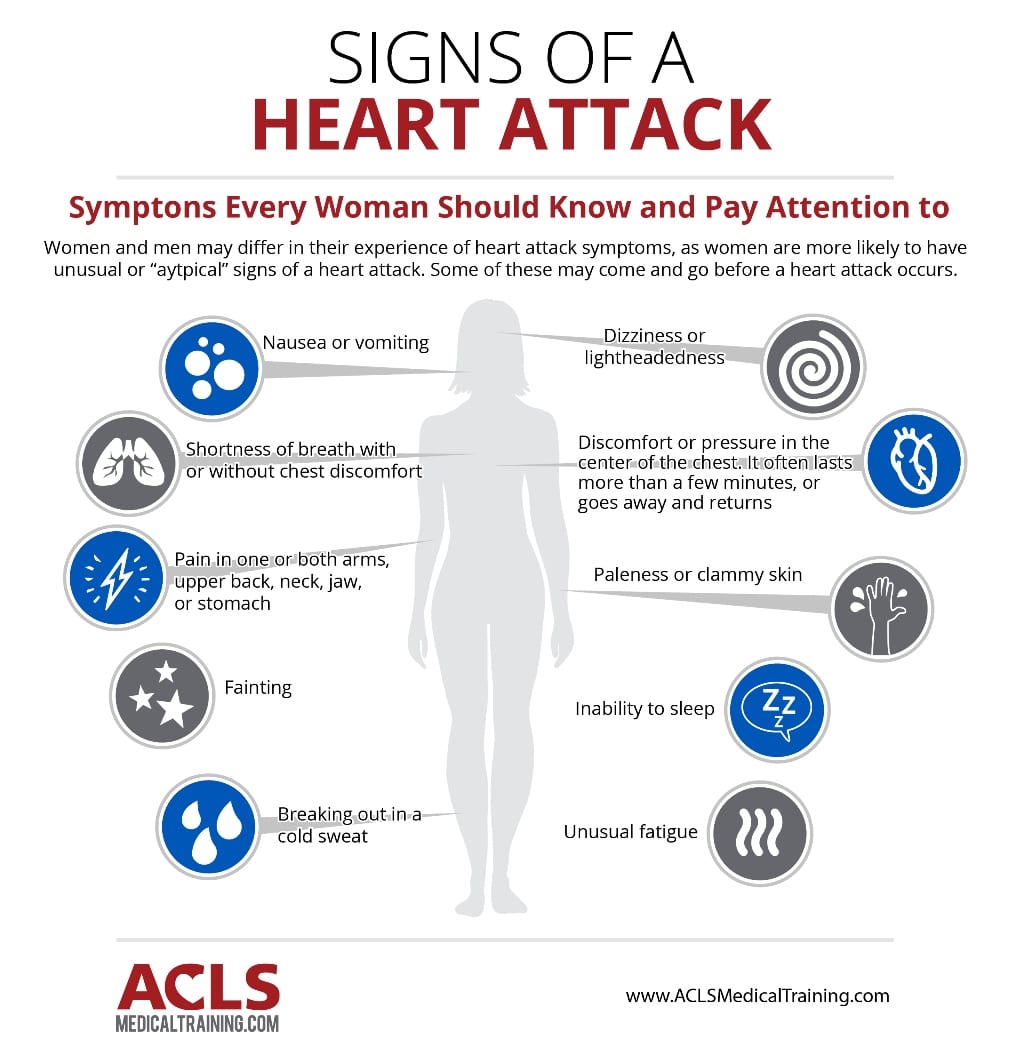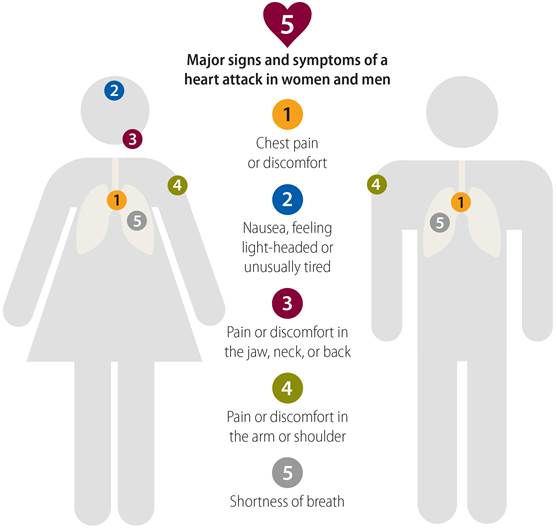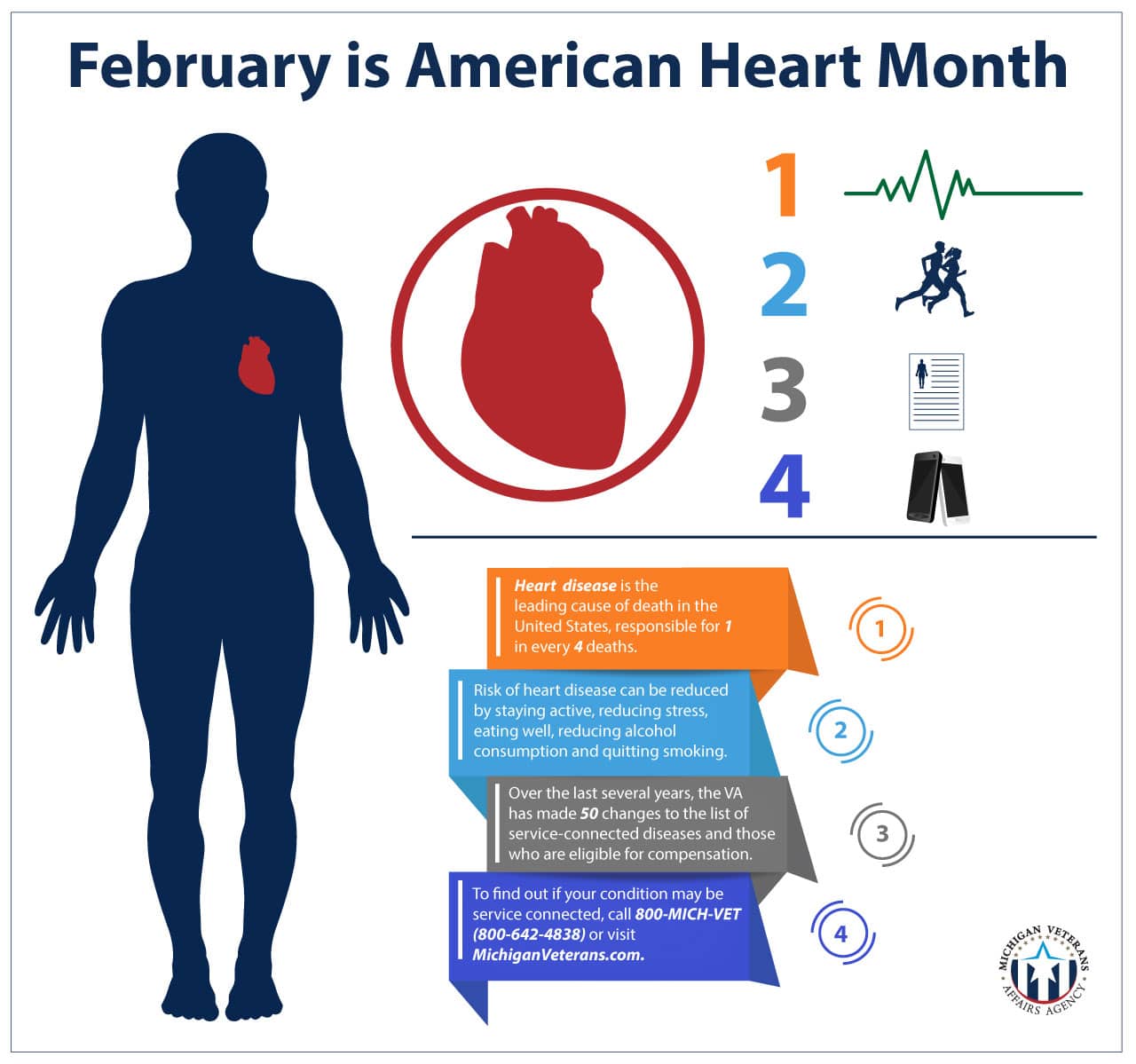Heart Attack: Men Vs Women
A heart attack occurs when heart disease has reached the point that blood flow to the heart is blocked. Sudden cardiac arrest is when the heart malfunctions and suddenly stops beating unexpectedly. A heart attack is a circulation problem and sudden cardiac arrest is an electrical problem. In a heart attack if the blocked artery is not reopened quickly, the part of the heart normally nourished by that artery begins to die. The longer a person goes without treatment, the greater the damage. Symptoms of a heart attack may be immediate and intense. More often, though, symptoms start slowly and persist for hours, days or weeks before a heart attack. Heart disease is most often the cause of a heart attack.
SIGNS OF HEART DISEASEHeart and blood vessel disease also called heart disease includes numerous problems, many of which are related to a process called atherosclerosis. Atherosclerosis is a condition that develops when a substance called plaque builds up in the walls of the arteries. This buildup narrows the arteries, making it harder for blood to flow through. If a blood clot forms, it can stop the blood flow. This can cause a heart attack or stroke. The first sign of heart disease is often a heart attack or other serious event. But, there are a few important signs that can help you recognize problems before they come to a head.
Determining Heart Disease Risk In Women
Women and men share many heart disease risk factors, but recent studies are showing what previous male-focused studies have not shown: Women also have their own unique heart disease risk factors.
Traditional risk factors common to both women and men:
- Metabolic syndrome the co-existence of high blood pressure, obesity, and high glucose and triglyceride levels
- High levels of C-reactive protein a sign of inflammatory disease that can occur along with other cardiovascular risk factors
Some risk factors that relate specifically to women or that can affect women disproportionately include:
- Relatively high testosterone levels prior to menopause
- Increasing hypertension during menopause
- Autoimmune diseases such as rheumatoid arthritis more common in women than in men
- Stress and depression also more common among women
- Low risk factor awareness Lack of recognition of many of the above conditions as risk factors for heart disease is a risk factor in itself
How Do You Know If Youre Having A Heart Attack
A wide array of conditions are associated with the symptoms weve listed here, so you may be wondering: Just how do you tell if youre in danger of a heart attack?
The chances that these symptoms are due to a decreased blood supply the heart muscle are increased if you have at least one of the following risk factors:
Diabetes
A first degree relative with a history of Coronary Artery Disease
Cigarette Smoking
History of plaque Buildup In any other Arteries
History of a Stroke or Peripheral Artery Disease
Menopause
Use of Certain Oral Contraceptive Pills
Having one of these symptoms on its own is unlikely to be due to a heart attack. When several of these symptoms occur at the same time or if you have any of these symptoms and you have any of the risk factors listed above its best to seek medical attention right away
Recommended Reading: How To Prevent Heart Attacks
Heart Attack Or Something Else
Although a heart attack may be the first thing that comes to mind, other common medical conditions can cause similar symptoms.
Dr. Vaishnav notes these conditions can mimic a heart attack:
- Musculoskeletal pain
- Pulmonary embolism
- Emotional stress
If you’re having symptoms, even minor ones, talk to your doctor or head to the nearest emergency room.
Wed much rather you get checked and be fine, Dr. Vaishnav says.
Shoulder Pain From Heart Attack

Although heart attack is most commonly associated with chest pain, it can also cause pain or discomfort in other parts of the body, including the shoulder.
Both women and men may experience shoulder pain during a heart attack. Some research suggests shoulder pain during a heart attack may be more common in women than men.
A 2018 study looked at 532 people who had an ST-elevation myocardial infarction , a type of heart attack that affects the whole heart muscle wall. Shoulder pain was twice as common in women than men. Throat and back pain were also more common in women.
Heart attack in men usually causes chest pain or discomfort, which may feel like pain, heaviness, pressure, fullness, squeezing, or heartburn. It typically lasts for more than a few minutes or goes away but returns again.
Read Also: Signs Of Congested Heart Failure
Learn More About Heart Disease Risk Factors And Symptoms That Are Unique To Women And Unique To You
Because heart disease and heart attack symptoms in women sometimes dont include the classic angina or chest pain, Barouch stresses the importance of paying attention to your body, and not being shy about asking questions. If you dont feel right, and especially if you have symptoms such as difficulty breathing, persistent nausea and abdominal pain, or any other unusual symptoms, you should talk to your doctor and not just shrug it off.”
Signs And Symptoms Of Heart Attack
If you have any of these signs, call 9-1-1 and get to a hospital right away.
Recommended Reading: What Does Congestive Heart Failure Mean
When To Call 911
If you suspect that you or someone else might be having a heart attack, call 911 or local emergency services right away. Immediate treatment can be lifesaving.
Long-term follow-up care is also important to improve outcomes.
Heart attack causes damage to your heart muscle, which can lead to potentially life threatening complications. Although more research is needed, some complications appear to be more common in women than men.
According to a 2016 review from the AHA, women are more likely than men to develop symptoms of heart failure following a heart attack. They also have a higher risk of death in the months and years following a heart attack.
The review found that 26 percent of women and 19 percent of men die within 1 year following a first heart attack, and 47 percent of women and 36 percent of men die within 5 years.
Some for these gender differences include:
- There may be a delay in recognizing womens symptoms.
- Women may be undertreated.
Heart Attack Symptoms: Are They Different Between Men And Women
2 min. read
Disponible en Español
While chest pain and shortness of breath have long been the telltale signs of a heart attack, these symptoms have been based on years of clinical research looking at what men experience.
But women have a higher risk of dying from a heart attack than men do. In many cases, thats because they dont realize they are having a heart attack and take too long to get help.
More recent studies have indicated that fewer women experience chest pain, or at least to the degree of pain or discomfort than men do.
More simply put: Women are less likely to have the typical heart attack seen in the movies.
Women could certainly experience chest pain, but they should also be on the lookout for less obvious symptoms, such as nausea, indigestion, and palpitations in addition to shortness of breath and back pain.
Nearly half of women in one study had no chest pain at all during their heart attack. Fatigue and shortness of breath were the most common symptoms.
Both women and men may have typical symptoms of heart attack, including chest pain or pressure often radiating to the shoulders, arms, neck or jaw and shortness of breath. These symptoms are usually made worse with exertion or stress, said Marcus St. John, M.D., interventional cardiologist, Baptist Cardiac & Vascular Institute. There are, however, several atypical symptoms of a heart attack and these tend to be more common in women.
Most common heart attack symptoms for men and women:
Recommended Reading: By-pass Heart Surgery
Women Are Less Likely To Survive A Heart Attack
More women than men die in the aftermath of a heart attack, according to a study published in Circulation. This may be because women tend to wait longer before going to the hospital, perhaps because their symptoms are vague or dont seem life-threatening, says Dr. Goyfman. Once at the ER, theyre less likely to get the right kind of treatment because their heart attacks can be harder to diagnose, he adds. Womens heart attacks are also more likely to be caused by blockages to small arteries, which angiograms often cant pick up.
What Is The Difference Between A Heart Attack And Cardiac Arrest
A heart attack is not the same as cardiac arrest. In a heart attack, the heart keeps beating. The person has a pulse and usually stays conscious . During cardiac arrest, the heart stops beating. The person has no pulse and is unconscious .
A defibrillator is a machine that sends an electrical shock to the heart to restore normal rhythm. This treatment must be given as soon as possible. For cardiac arrest, call 911 and begin CPR right away. The American Heart Association says that with “hands only” CPR, anyone can give lifesaving treatment to someone having cardiac arrest. Push hard and fast in the center of the chest and keep going until emergency personnel arrive. Do not give CPR for a heart attack.
Don’t Miss: What To Expect After Infant Open-heart Surgery
Did We Answer Your Question About Heart Attack
For more information about heart attack, call the OWH Helpline at 1-800-994-9662 or check out the following resources from other organizations:
- Heart Attack â Information from the National Heart, Lung, and Blood Institute
- Heart Attack â Information from the Centers for Disease Control and Prevention
Heart Attack Symptoms Go Beyond Chest Pain

Portrayals in movies and TV shows often make heart attacks look like sudden, crushing chest pain. While chest discomfort, pressure, or pain are common symptoms of heart attack, they arent the only ones.
Women are more likely than men to have more subtle heart attack symptoms that may be unrelated to the chest. You could be having a heart attack if you experience pain in your:
Symptoms can be vague, and many women brush them off because theyre not widely known as signs of a heart attack. Learning to recognize the more subtle symptoms can help you identify a cardiac event sooner before permanent damage occurs.
Recommended Reading: What To Do To Lower Heart Rate
Heart Disease Is The Leading Cause Of Death Among Women And One Of The Most Preventable Research Is Giving Us Insights Into How We Can Control Our Risk
We’ve come a long way since the days when a woman’s worry over heart disease centered exclusively on its threat to the men in her life. We now know it’s not just a man’s problem. Every year, coronary heart disease, the single biggest cause of death in the United States, claims women and men in nearly equal numbers.
Treatment After A Heart Attack Is Often Less Aggressive For Women
After surviving a heart attack, women are at greater risk for blood clots that can cause another heart attack, according to the Cleveland Clinic. Yet, for unknown reasons theyre less likely to receive medication to prevent blood clots, which may explain why women are more likely to have a second heart attack within 12 months. Women are also less likely to be referred to a cardiac rehabilitation facility for heart health education and exercise, nutrition, and stress relief guidance. Over the past 30 years, fewer than one in five women whove had heart attacks received cardiac rehab care.
Read Also: How To Measure Your Resting Heart Rate
Warning Signs Of A Heart Attack In Women
People often think that heart attacks are something that happen to older men, not women. But heart disease is the leading cause of death for women in the United States.1 Yet only about half of women know this.1
Plus, the way women experience a heart attack can feel different from men. While both men and women may have chest pain during a heart attack, women tend to also have more symptoms than just chest pain.
Researchers found that when women have a heart attack, theyre more likely to experience 3 or more related symptoms compared to men.2 These symptoms may include jaw pain, neck pain, back pain, and shortness of breath, and can make it hard for women to tell if theyre having a heart attack.
Women are also more likely than men to think their heart attack symptoms are caused by anxiety and stress.2 This misunderstanding combined with a wider range of symptoms can cause women to wait longer to get treated.
Several studies have shown that women wait longer to get treatment for a heart attack than men, says Mingsum Lee, MD, a clinical cardiologist at Kaiser Permanentes Los Angeles Medical Center.
So, its important to learn these symptoms of a heart attack and know when to seek care.
Women And Heart Disease
The term heart disease refers to several types of heart conditions, including coronary artery disease and heart attack.
Although heart disease is sometimes thought of as a mans disease, almost as many women as men die each year of heart disease in the United States.
This map shows death rates from heart disease in women in the United States. The darker red indicates a higher death rate.
The map shows that concentrations of counties with the highest heart disease death rates meaning the top quintile are located primarily in Alabama, Mississippi, Louisiana, Arkansas, Oklahoma, Georgia, Kentucky, and Tennessee. Pockets of high-rate counties also were found in Michigan, Ohio, West Virginia, Virginia, North Carolina, South Carolina, Missouri, Texas, Nevada, and Montana.
Source: Interactive Atlas of Heart Disease and Stroke
Read Also: Final Stages Of Diastolic Heart Failure
Women Are Less Likely To Seek Immediate Care During A Heart Attack
Because female heart attack symptoms are often less obvious, women are more likely to chalk them up to other conditions and less likely to seek out emergency care. By the time they do receive care, theyve often experienced damage to their heart that could have been prevented with earlier intervention.
If you feel unwell and are experiencing any of the potential symptoms of a heart attack, its important to get to the emergency room as soon as possible to get it checked out. If youre having a heart attack, every minute matters in getting you the right care.
Led by distinguished cardiologist Dr. Henock St. Jacques, FACC, the experienced team at Harlem Cardiology is well-versed in helping women as well as men whove experienced heart attacks or have concerns about their heart health. We offer regular screening for coronary heart disease, as well as follow-up care for patients whove experienced heart attacks.
Located conveniently in Harlem, New York, Harlem Cardiology serves patients throughout the greater New York City area. Request your appointment online or by calling our practice.
Taking Your Health To Heart
Its important to understand your risk factors and be aware of common heart attack symptoms. Another way you can take care of your heart health is by focusing on prevention. You can find more heart-healthy lifestyle tips, as well as evidence-based treatments for cardiac care, on our heart health guide.
Don’t Miss: How Does Exercise Affect Heart Rate
How To Reduce Your Heart Attack Risk
Both men and women need to be aware of heart attack symptoms, along with risk factors that can increase their likelihood of having a heart attack. Talk to your doctor about heart-healthy lifestyle habits, such as smoking cessation, diet and exercise, to lower your chance of a heart attack and keep your heart beating strong for years to come.
Little To No Chest Pain

Chest pain is the most common heart attack or pre-heart attack symptom in both women and men. However, for men, the pain is often localized to their left side and the most prominent and severe symptom of a heart attack. Chest pain in a woman can be a subtler signal thats less easy to interpret.
Women might experience chest pain from a heart attack as a fullness or a vice-like squeezing throughout the chest. It also is often not the most prominent symptom, so women should be mindful of the suite of other symptoms that manifest at the same time, with the big one being
Don’t Miss: Does Exercise Lower Heart Rate
Heart Attack In Women Over 50
After menopause, which generally occurs around age 50, your risk of heart attack increases. During this period of life, your levels of the hormone estrogen drop. Estrogen is believed to help protect the health of your heart, which could explain why the average age of first heart attack is roughly 5 years older in women than in men.
There are additional symptoms of a heart attack that women over the age of 50 may experience. These symptoms include:
- severe chest pain
A silent heart attack is like any other heart attack, except it occurs without the usual symptoms. In other words, you may not even realize youve experienced a heart attack.
The American Heart Association estimates that as many as 170,000 Americans experience heart attacks each year without even knowing it. Though less symptomatic than a full heart attack, these events cause heart damage and increase the risk of future attacks.
Silent heart attacks are more common among people with diabetes and in those whove had previous heart attacks.
Symptoms that may indicate a silent heart attack include:
- mild discomfort in your chest, arms, or jaw that goes away after resting
- shortness of breath and tiring easily
- sleep disturbances and increased fatigue
- abdominal pain or heartburn
- skin clamminess
